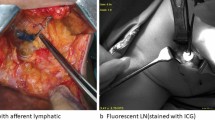Abstract
Background
Methylene blue (M), as a dye in sentinel lymph node mapping (SLNM), has been introduced as an alternative to lymphazurin (L) after the recent shortage of L. M has been evaluated in breast cancer in multiple studies with favorable results. Our study compares L with M in the SLNM of gastrointestinal (GI) tumors.
Methods
Between Jan 2005 and Aug 2008, 122 consecutive patients with GI tumors were enrolled. All patients (pts) underwent SLNM with either L or M by subserosal injection of 2–5 mL of dye. Efficacy and rates of adverse reactions were compared between the two dyes. Patients were prospectively monitored for adverse reactions including anaphylaxis, development of blue hives, and tissue necrosis.
Results
Of 122 pts, 60 (49.2%) underwent SLNM using L and 62 (50.8%) underwent SLNM using M. Colon cancer (CrCa) was the most common site in both groups. The success rate of L and M in SLNM was 96.6% and 96.7%, respectively, with similar numbers of total number of lymph nodes per pt, SLNs per pt (<3), nodal positivity, skip metastasis, and accuracy. The only adverse reaction in the L group was oxygen desaturation >5% in 5% (3/60) of pts, compared with none in the M group. Cost per vial of L was $210 vs $7 for M.
Conclusion
The success rate, nodal positivity, average SLNs per patient, and overall accuracy were similar between L and M. Absence of anaphylaxis and lower cost make M more desirable than L in SLNM of GI tumors.


Similar content being viewed by others
References
Cabanas RM. An approach for the treatment of penile carcinoma. Cancer. 1977;39:456–6.
Morton DL, Wen DR, Wong JH, Economou JS, Cagle LA, Storm FK, et al. Technical details of intraoperative lymphatic mapping for early stage melanoma. Arch Surg. 1992;127:392–9.
Giuliano AE, Kirgan DM, Guenther JM, Morton DL. Lymphatic mapping and sentinel lymphadenectomy for breast cancer. Ann Surg. 1994;220:391–8; discussion 398–401.
Giuliano AE, Jones RC, Brennan M, Statman R. Sentinel lymphadenectomy in breast cancer. J Clin Oncol. 1997;15:2345–50.
Tsoulias GJ, Wood TF, Morton DL, Bilchik AJ. Lymphatic mapping and focused analysis of sentinel lymph nodes upstage gastrointestinal neoplasms. Arch Surg. 2000;135:926–32.
Saha S, Dan AG, Bilchik AJ, Kitagawa Y, Schochet E, Choudhri S, et al. Historical review of lymphatic mapping in gastrointestinal malignancies. Ann Surg Oncol. 2004;11:245S–9S.
Burian, M, Stein HJ, Sendler A, Piert M, Nährig J, Feith M, et al. Sentinel node detection in Barrett’s and Cardia cancer. Ann Surg Oncol. 2004;11:255S–8S.
Saha S, Ganatra BK, Gauthier J, et al. Localization of sentinel lymph node in colon cancer. A feasibility study. In Society of Surgical Oncology 50th Annual Cancer Symposium. vol. 54, 1997. p. 80.
Saha S, Dan AG, Berman B, Wiese D, Schochet E, Barber K, et al. Lymphazurin 1% versus 99mTc sulfur colloid for lymphatic mapping in colorectal tumors: A comparative analysis. Ann Surg Oncol. 2004;11:21–6.
Dan AG, Saha S, Monson KM, Wiese D, Schochet E, Barber KR, et al. 1% lymphazurin vs 10% fluorescein for sentinel node mapping in colorectal tumors Arch Surg. 2004;139:1180–4.
Saha S, Seghal R, Patel M, Doan K, Dan A, Bilchik A, et al. A multicenter trial of sentinel lymph node mapping in colorectal cancer: prognostic implications for nodal staging and recurrence. Am J Surg. 2006;191:305–10.
Kitagawa Y, Saha S, Kubo A, Kitajima M. Sentinel node for gastrointestinal malignancies. Surg Oncol Clin N Am. 2007;16:71–80.
Levenback CF. Status of sentinel lymph node biopsy in gynecological cancers. Surg Oncol. 2008;15:18–20.
Simmons R, Thevarajah S, Brennan MB, Christos P, Osborne M. Methylene blue dye as an alternative to isosulfan blue dye for sentinel lymph node localization. Ann Surg Oncol. 2003;10:242–7.
Sandhu, S, Farag E, Argalious, M. Anaphylaxis to isosulfan blue dye during sentinel lymph node biopsy. J Clin Anesth. 2005;17:633–5.
Thevarajah S, Huston TL, Simmons RM. A comparison of the adverse reactions associated with isosulfan blue versus methylene blue dye in sentinel lymph node biopsy for breast cancer. Am J Surg. 2005;189:236–9.
Leong SP, Donegan E, Heffernon W, Dean S, Katz JA. Adverse reactions to isosulfan blue during selective sentinel lymph node dissection in melanoma. Ann Surg Oncol. 2000;7:361–6.
Kaufman, G, Guth AA, Pachter HL, Roses DF. A cautionary tale: Anaphylaxis to isosulfan blue dye after 12 years and 3339 cases of lymphatic mapping. Am Surg. 2008;74:2.
Dewachter P, Mouton-Faivre C, Tréchot P, Lleu JC, Mertes PM. Severe anaphylactic shock with methylene blue instillation. Anesth Analg. 2005;101:149–50.
Millo T, Misra R, Girdhar S, Rautji R, Lalwani S, Dogra TD. Fatal pulmonary edema following laparascopic chromopertubation. Natl Med J India. 2006;19:78–9.
Saha S, Dan AG, Viehl CT, Zuber M, Wiese D. Sentinel lymph node mapping in colon and rectal cancer: Its impact on staging, limitations, and pitfalls. Cancer Treat Res. 2005;127:105–22.
Momeni R, Ariyan S. Pulse oximetry declines due to intradermal isosulfan blue dye: A controlled prospective study. Ann Surg Oncol. 2004;11:434–7.
Morell, R, Heyneker T, Kashtan HI, Ruppe C. False desaturation due to intradermal patent blue dye. Anesthesiology. 1993;78:363–4.
Vokach-Brodsky L, Jeffrey SS, Lemmens HJ, Brock-Utne JG. Isosulfan blue affects pulse oximetry. Anesthesiology. 2000;93:1002–3.
Vieira SC, Sousa RB, Tavares MB, de Abreu BA, Ibiapina JO, de Sousa Oliveira AK, et al. Changes in pulse oximetry after patent blue dye injection into uterine the uterine cervix. Ann Surg Oncol. 2008;15:2862–6.
Author information
Authors and Affiliations
Corresponding author
Rights and permissions
About this article
Cite this article
Soni, M., Saha, S., Korant, A. et al. A Prospective Trial Comparing 1% Lymphazurin vs 1% Methylene Blue in Sentinel Lymph Node Mapping of Gastrointestinal Tumors. Ann Surg Oncol 16, 2224–2230 (2009). https://doi.org/10.1245/s10434-009-0529-y
Received:
Revised:
Accepted:
Published:
Issue Date:
DOI: https://doi.org/10.1245/s10434-009-0529-y




